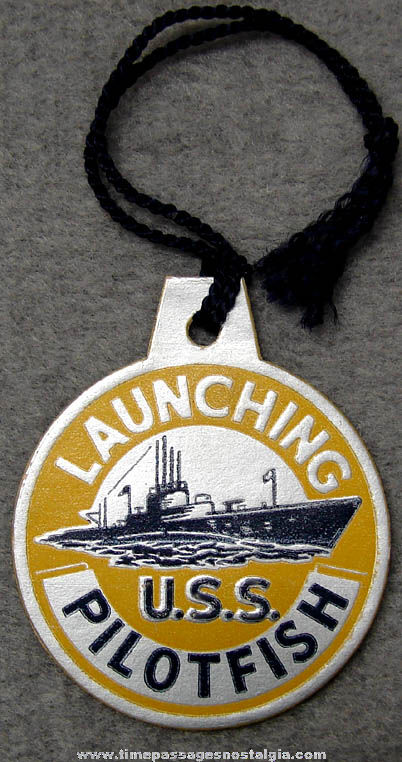
   | | Any group of items being offered as a lot must be sold as a lot. | | | | An Ever Changing Inventory |  | It's never too late to
have a happy childhood! | Great memories
make great gifts! | Nostalgic Memorabilia, Pop Culture Artifacts, Historic Items,
and "Shoe Box Toys" | Whether you've collected Memorabilia for years or just want to feel like a kid again, please take a few moments to browse through what we
have available for sale. | | Quality Merchandise At Reasonable Prices | | Combined Shipping And Handling |
| | | | The picture shows a view of this 1943 U.S.S. Pilotfish SS-386 Submarine Launching Souvenir Tag. This launching badge is believed to have been saved by a Portsmouth Naval Shipyard worker. It was found in Maine with many others dating from 1943 to 1944 when many ships and submarines were built and launched to do battle in World War II. They had been hidden away since the 1940s until 2009. The submarine was launched from The Portsmouth Naval Ship Yard in Kittery, Maine. This cardboard tag has its original black cord attached. It is imprinted in black and gold on a silver background. The back side is identical. It pictures a United States Navy Submarine and it is marked as follows: LAUNCHING
U.S.S. PILOTFISH The tag measures 1-3/4'' wide. It is in mint condition as pictured. Below here, for reference, is some historical information on the U.S.S. Pilotfish SS-386 submarine: USS Pilotfish (SS-386)
From Wikipedia, the free encyclopedia Career Builder: Portsmouth Naval Shipyard, Kittery, Maine
Laid down: 15 May 1943
Launched: 30 August 1943
Commissioned: 16 December 1943
Decommissioned: 29 August 1946
Struck: 25 February 1947
Fate: Used as a target for the Operation Crossroads atomic bomb test, 25 July 1946, and sunk General characteristics Class and type: Balao class diesel electric submarine
Displacement: 1,526 tons (1,550 t) surfaced, 2,391 tons (2,429 t) submerged
Length: 311 ft. 6 in. (94.9 m)
Beam: 27 ft. 3 in. (8.3 m)
Draft: 16 ft. 10 in. (5.1 m) maximum
Propulsion: 4 Fairbanks-Morse Model 38D8, 10 cylinder opposed piston diesel engines driving electrical generators, 2 126-cell Sargo batteries,
4 high speed Elliott electric motors with reduction gears, two propellers, 5,400 shp (4.0 MW) surfaced, 2,740 shp (2.0 MW) submerged
Speed: 20.25 knots (38 km/h) surfaced, 8.75 knots (16 km/h) submerged
Range: 11,000 nautical miles (20,000 km) surfaced at 10 knots (19 km/h)
Endurance: 48 hours at 2 knots (3.7 km/h) submerged 75 days on patrol
Test depth: 400 ft. (120 m)
Complement: 10 officers, 70 - 71 enlisted
Armament: 10 21-inch (533 mm) torpedo tubes (six forward, four aft), 24 torpedoes, 1 4-inch (102 mm) / 50Ęcaliber deck gun, 4 machine gunsU.S.S. Pilotfish (SS-386), a Balao class submarine, was a ship of the United States Navy named for the pilotfish, a carangoid fish, often seen in warm latitudes in company with sharks. Pilotfish was laid down by the Portsmouth Navy Yard, in Kittery, Maine, 15 May 1943; launched 30 August 1943; sponsored by Mrs. Martha Szolmeczka Scheutz; and commissioned 16 December 1943, Lieutenant Commander Robert H. Close in command. After underway trials, training, and shakedown in the Portsmouth area, Pilotfish departed New London 29 March 1944 for the Pacific via the Panama Canal. She reported to Commander in Chief, Pacific Fleet 10 April and joined Submarine Division 202, Submarine Squadron 20. On 16 May, Pilotfish departed on her first patrol in company with the USS Pintado (SS-387) and the USS Shark (SS-314). This patrol was begun in the area west of the Mariana Islands. After a week the group sailed to an area south of Formosa and patrolled across a probable route of reinforcement or retirement of the Japanese forced engaged in the Battle of the Philippine Sea. This proved fruitless and Pilotfish set course for Majuro Atoll, Marshall Islands, arriving 4 July. Pilotfish departed on her second war patrol in the Bonin Islands area 27 July. She performed lifeguard duty in addition to offensive patrol. She returned via Midway to Pearl Harbor, 14 September. Pilotfish departed 14 October via Midway Island on her third war patrol, again in the Bonins area. On 31 October she torpedoed and damaged a 4,000 ton cargo ship. On 2 November Pilotfish proceeded to the Nansei Shoto area for the balance of the patrol. After 57 days of patrol, she returned to Midway Island, arriving 10 December. On 20 January 1945 Pilotfish departed on her fourth war patrol, in company with the USS Finback (SS-230) and the USS Rasher (SS-269). The group proceeded via Saipan to the East China Sea area, where a long patrol brought no contacts but a hospital ship and small craft. Pilotfish returned to Pearl Harbor, 25 March. On 21 May Pilotfish departed for her fifth patrol. She spent fifteen days on lifeguard duty off Marcus Island, then proceeded to Tanapag Harbor, Saipan. On 20 June Pilotfish left for the second half of her lifeguard patrol in the vicinity of the Japanese Home Islands. Pilotfish arrived Apra Harbor, Guam, 14 July. On 9 August Pilotfish departed on her sixth patrol, again to lifeguard duty. Only two days had been spent in the patrol area, southeast of Japan, when on 15 August the ''Cease Firing'' order arrived. Pilotfish remained on station off Kii Suido for continued lifeguard duty, and neutrality patrol. On 31 August Pilotfish rendezvoused with other ships and proceeded to Tokyo Kaiwan in order to participate in the initial occupation of Japan and the formal surrender ceremonies. The afternoon of 31 August all submarines of the formation moored alongside the USS Proteus (AS-19) in Yokosuka Naval Basin. On 3 September, Pilotfish got underway for Pearl Harbor and San Francisco. By directive dated 1 July 1946 Pilotfish was to be disposed of by use as a target for the Operation Crossroads atomic bomb test at Bikini Atoll. She was decommissioned on 29 August 1946 and was struck from the Naval Vessel Register 25 February 1947. Pilotfish received five battle stars for World War II service. |
|
Click on image to zoom.
 |